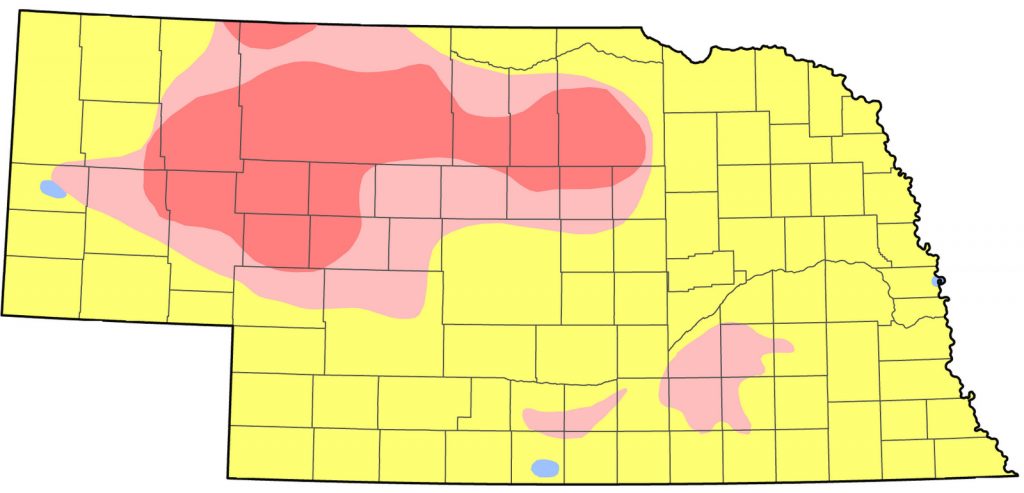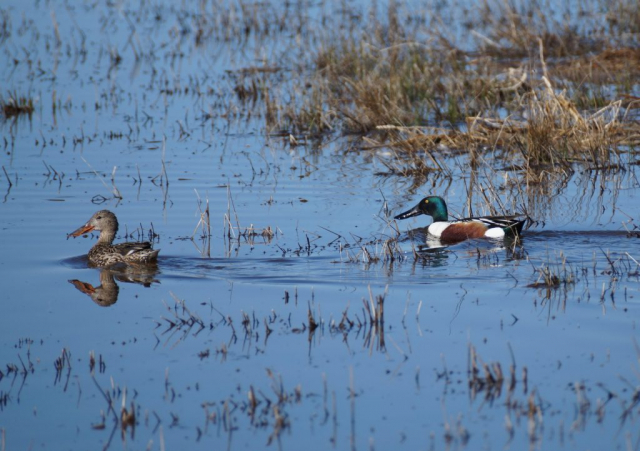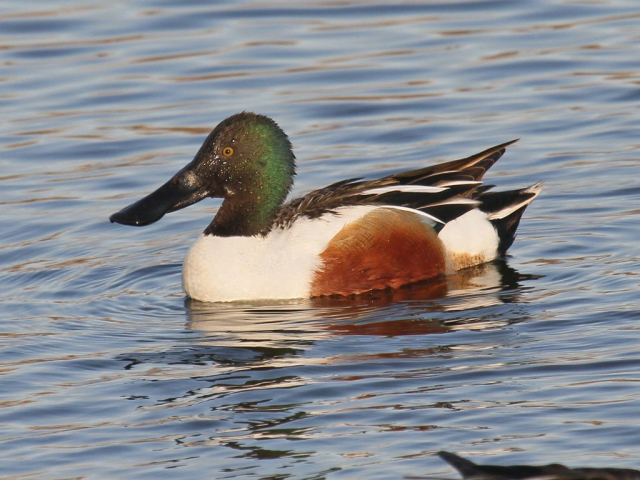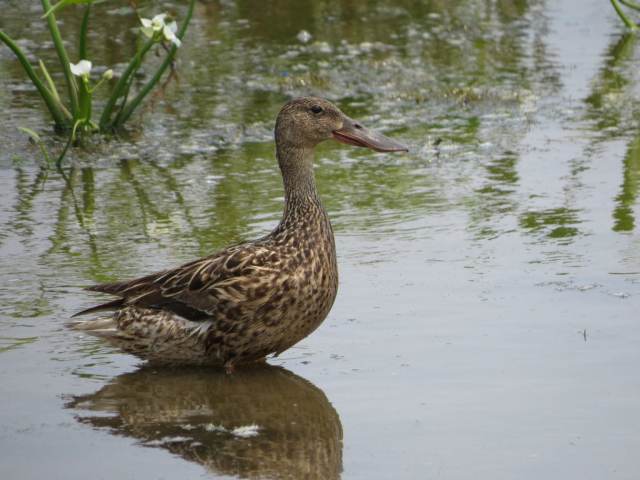Spatula clypeata
Status: Common, locally abundant, regular spring migrant statewide. Locally common regular breeder north central and Panhandle, rare elsewhere. Common regular fall migrant statewide. Uncommon regular winter visitor south, east, and North Platte River Valley, rare casual elsewhere.

Documentation: Specimen: UNSM ZM12449, 14 Apr 1909 Cass Co.
Taxonomy: No subspecies are recognized (AviList 2025).
This species was recently moved to genus Spatula from Anas, based on genetic studies (Chesser et al 2017).
Northern Shoveler hybridizes with other species. There is one Nebraska record of Northern Shoveler x Gadwall, a bird photographed in Clay Co 9 May 2020 (Peterson, eBird.org; see Northern Shoveler x Gadwall (hybrid). There are also Nebraska records of Blue-winged Teal x Northern Shoveler (hybrid) and Cinnamon Teal x Northern Shoveler hybrid).
Spring: There are numerous records for Jan-Feb in the Missouri River Valley, Platte River Valley southward, and North and South Platte River Valleys in the Panhandle. The only records elsewhere of presumed early migrants are 17 Feb 2012 two in Garfield Co, 21 Feb 2011, two in Garfield Co, and 27 Feb 2017 two in Stanton Co; these dates suggest northward movement beginning in mid- to late Feb, although first arrivals are typically in early Mar as water opens up. Numbers peak in Apr.
- High counts: 4500 at Island Lake, Crescent Lake NWR, Garden Co 3 Apr 2024, 3700 at North Platte SL, Lincoln Co 2 May 2004, 3300 at Harvard and Massie WPAs, Clay Co 9 Apr 2000, and 3000 at Carter Lake, Omaha 10 Apr 2014.
Summer: Breeding may occur throughout the state (Ducey 1988), but most are found in the Sandhills and fewest in the south and east. It is a rare breeder in the Rainwater Basin (Jorgensen 2012); Evans and Wolfe (1967) only located five Northern Shoveler nests out of 206 duck nests 1958-1962, and Harding (1986) found only eight nests out of 723 total duck nests in Clay Co 1981-85. The few recent reports of breeding in the Rainwater Basin are of a brood in 1999, two broods in 2001, broods in Seward Co 16 Jul 2005 and 20 May 2007, and hen flushed off a nest at Krause WPA, Fillmore Co 31 May 2019 (Jorgensen and Brenner 2019).
Reports mid-Jun through mid-Jul away from the mapped summer range may indicate breeding.
- Breeding phenology:
- Courtship: 4 Apr-1 May
Eggs/Incubation: 4 May- 26 Jun (Mollhoff 2022)
Dependent fledglings: 20 May- 20 Jul
Fall: Primary migration commences in Sep when the species becomes more common and widespread; peak numbers are attained in mid- to late Oct. Numbers decline in Nov but reports in Dec and Jan are common (see Winter). Best late counts are 204 on 14 Dec 2002 in Scotts Bluff Co, 120 at North Platte WTP, Lincoln Co 2 Jan 2025, and 110 at Holmes Lake, Lancaster Co 7 Dec 2015.
Individuals and small groups may undertake short distance movements ahead of primary migration and appear away from breeding areas by late summer. Males generally leave nesting sites to molt in groups nearby in late Jun and Jul (Baldassarre 2014); a flock of 29 near North Platte, Lincoln Co 19 Jun 2012 consisted of 20 females and juveniles with nine molting males undergoing pre-alternate molt into “eclipse” plumage (Howell 2010).
- High counts: 2000 at North Platte WTP 8 Oct 1996, “thousands” there 11 Oct 2005, 1700 there 8 Dec 1999, 1500 at Rat and Beaver Lake WMA, Cherry Co 10 Nov 2019, and 1010 at North Platte WTP 3 Nov 2023.
Winter: Overwintering occurs most often in the North Platte River Valley, notably in Scotts Bluff and Lincoln Cos, but there are also multiple reports of overwintering at Alma, Harlan Co, including 76 there 5 Feb 2000, and in the southeast, notably at Carter Lake, Douglas Co, where up to 700 wintered in the years 2011-2016; 1000 were there 8 Dec 2012. One wintered with Mallards at Jackson, Dakota Co 1995-1996. Mid-winter records are widespread and increasing in the late 2010s in the south and east. The only mid-winter record (mid-Jan through mid-Feb) elsewhere is the 17 on 17 Jan 2000 in Sioux and Dawes Cos.
Images
Abbreviations
SL: Sewage Lagoons WPA: Waterfowl Production Area (Federal)
UNSM: University of Nebraska State Museum
WMA: Wildlife Management Area (State)
WTP: Waterfowl Production Area (Federal)
Acknowledgement
Photograph (top) of a Northern Shoveler at Fontenelle Forest, Sarpy Co, on 6 Apr 2011 by Phil Swanson.
Literature Cited
AviList Core Team, 2025. AviList: The Global Avian Checklist, v2025. https://doi.org/10.2173/avilist.v2025.
Baldassarre, G. 2014. Ducks, geese, and swans of North America. Johns Hopkins University Press, Baltimore, Maryland, USA.
Chesser, R.T., K.J. Burns, C. Cicero, J.L. Dunn, A.W. Kratter, I.J. Lovette, P.C. Rasmussen, J. V. Remsen, Jr., J.D. Rising, D.F. Stotz, and K. Winker. 2017. Fifty-eighth supplement to the American Ornithological Society’s Check-list of North American Birds. Auk 134: 751-773.
Ducey, J.E. 1988. Nebraska birds, breeding status and distribution. Simmons-Boardman Books, Omaha, Nebraska, USA.
Evans, R.D., and C.W. Wolfe. 1967. Waterfowl production in the Rainwater Basin area of Nebraska. Journal of Wildlife Management 33: 788-794.
Harding, R.G. 1986. Waterfowl nesting preferences and productivity in the Rainwater Basin, Nebraska. Master’s thesis, Kearney State College, Kearney, Nebraska.
Howell, S.N.G. 2010. Molt in North American Birds. Houghton Mifflin Harcourt, Boston, Massachusetts, USA.
Jorgensen, J.G. 2012. Birds of the Rainwater Basin, Nebraska. Nebraska Game and Parks Commission, Lincoln, Nebraska, USA.
Jorgensen, J.G., and S.J. Brenner. 2019. Notable avian nesting records from the Rainwater Basin, Nebraska — 2019. Nongame Bird Program of the Nebraska Game and Parks Commission, Lincoln, Nebraska, USA.
Mollhoff, W.J. 2022. Nest records of Nebraska birds. Nebraska Ornithologists’ Union Occasional Paper Number 9.
Recommended Citation
Silcock, W.R., and J.G. Jorgensen. 2025. Northern Shoveler (Spatula clypeata). In Birds of Nebraska — Online. www.BirdsofNebraska.org
Birds of Nebraska – Online
Updated 5 Jul 2025



